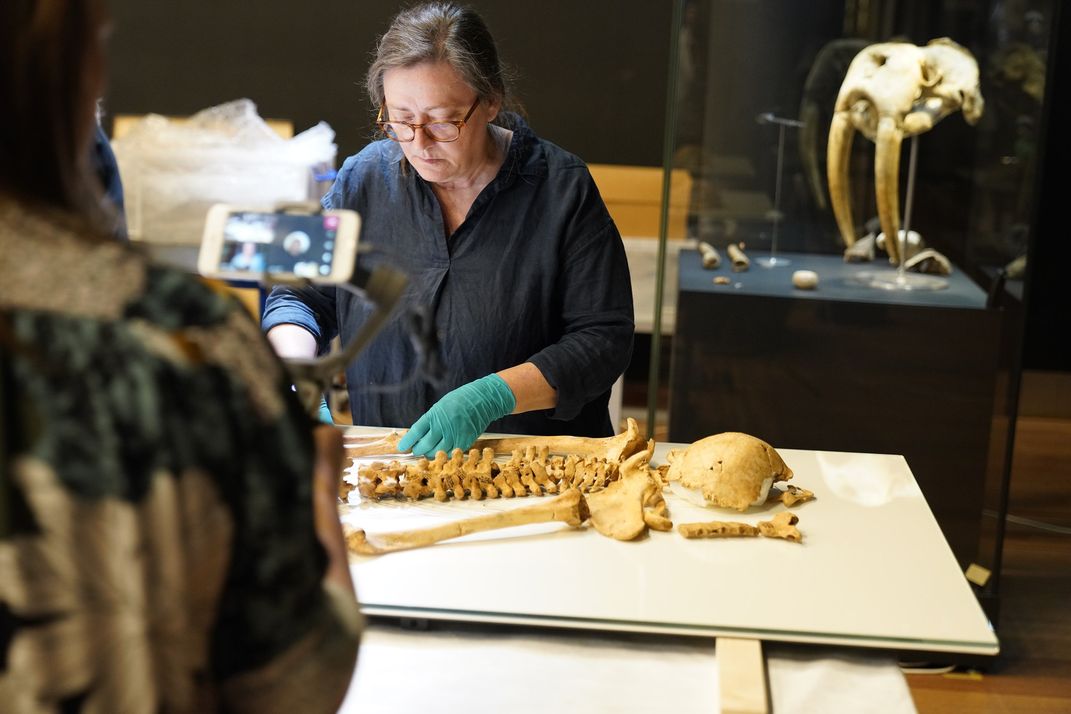Viking-Era Relatives Who Died on Opposite Sides of the Sea Reunited at Last
Either half-brothers or a nephew and uncle, one died after taking part in a raid, while the other was the victim of an English massacre
:focal(936x906:937x907)/https://tf-cmsv2-smithsonianmag-media.s3.amazonaws.com/filer/c3/21/c3219257-af2e-4405-b30b-948e70b6a639/reunion2.jpg)
About 1,000 years ago, two closely related men died violently, one on the Danish island of Funen and the other in Oxford, England. Now, reports Jan M. Olsen for the Associated Press (AP), scientists are reuniting the pair’s remains for an exhibition at the National Museum of Denmark in Copenhagen.
The man who passed away on Funen was a farmer in his 50s with a number of healed injuries that suggest he took part in Viking raids. He likely died as a result of a raid in which he sustained a stab wound to his left pelvis.
“[T]hat blow may have cost him his life because it did not heal,” says Jesper Hansen, chief curator for Odense City Museums, in a statement.
Archaeologists excavated the man’s skeleton in 2005. Examining it, they found he stood just under six feet tall and suffered from arthritis and possibly tuberculosis.
Researchers found the remains of the other Viking, who was in his 20s when he died, in a mass grave beneath the campus of Oxford’s St. John’s College in 2008. He was buried alongside at least 35 other men between the ages of 16 and 25, reports the Guardian’s Ian Sample.
Per the Guardian, the team believes that the second man was a victim of the St. Brice’s Day massacre of November 13, 1002. After the Saxon king Ethelred the Unready learned of a Danish plot to assassinate him (or at least claimed he had), he ordered the killing of all Danes in England. When Danes living in Oxford retreated to St. Frideswide’s Church, a mob set the building on fire.
Archaeologists say attackers cut or stabbed the man at least nine times, in addition to spearing him several times in the back.

“He died of massive injuries from several types of weapons,” says Lasse Soerensen, head of research at the National Museum, in the statement.
Eske Willerslev, a geneticist at Copenhagen University, tells Deutsche Welle (DW) that DNA testing of the two skeletons found they were either half-brothers or a nephew and uncle. The two lived around the same time but may have been separated by as much as 50 years.
“It’s very difficult to tell if they lived in the same age or they differ maybe by a generation, because you have no material [in the graves] that can give a precise dating,” says Jeanette Varberg, an archaeologist at the National Museum, to DW.
The researchers were able to discover the men’s genetic connection—and other details about their lives—thanks to advances in DNA and strontium isotope testing, which offers insights into the movements of people around the ancient world. A separate 2020 study examined the DNA of 442 northern Europeans who lived during the Bronze Age through medieval periods, comparing them with more than 4,000 previously studied individuals. This work turned up several cases of people who were related to each other, including the two Viking men. As Erin Blakemore reported for National Geographic at the time, the research also found that Vikings were a genetically diverse group united by culture and social ties rather than common ancestry.
The National Museum is displaying the two skeletons as part of an exhibition titled “Togtet,” or “The Raid.” Centered on Viking seafaring, fighting and culture, the show opens on June 26.
/https://tf-cmsv2-smithsonianmag-media.s3.amazonaws.com/accounts/headshot/Livia_lg_thumbnail.png)
/https://tf-cmsv2-smithsonianmag-media.s3.amazonaws.com/accounts/headshot/Livia_lg_thumbnail.png)